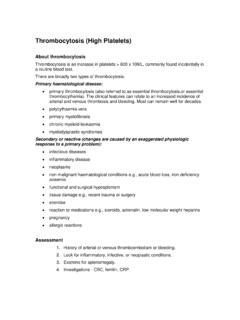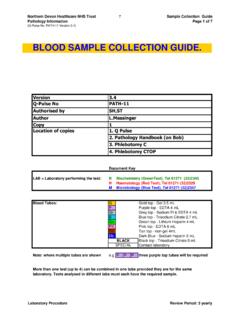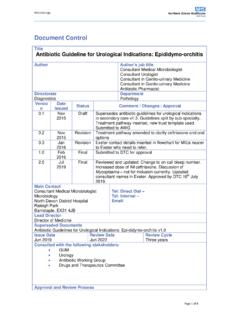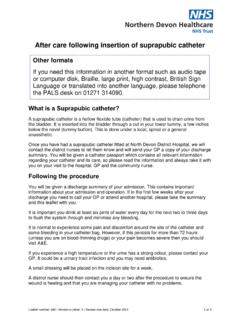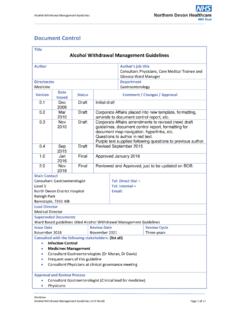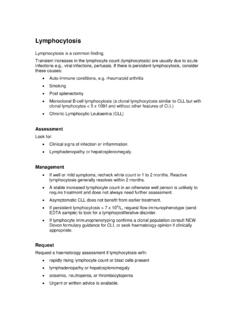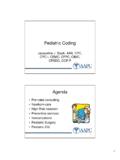Transcription of Document Control - Northern Devon Healthcare NHS Trust
1 Neonatal and Paediatric High-Flow Nasal Cannula Oxygen Therapy Guideline Amended Sept 2018 Medical Page 1 of 18 Document Control Title Neonatal and Paediatric High-Flow Nasal Cannula Oxygen Therapy Guideline Author Author s job title Directorate Medical Department Paediatrics / Neonates Version Date Issued Status Comment / Changes / Approval Jul 2016 Draft Initial version for consultation Dec2016 Draft Additions made with comments by Lead Nurse LM. Mar2017 Final Addition made with regards to weaning 1 Mar 2017 Final Approved by Paediatric Speciality Team on 31st March 2017.
2 July 2018 Amended Some amendments made to clarify weaning differences between SCBU and PHDU. Sept 2018 Amended Flow chart for Paediatrics update to include Caroline Thorpe ward use Main Contact North Devon District Hospital Raleigh Park Barnstaple, EX31 4JB Tel: Direct Dial Tel: Internal Email: Lead Director Director of Paediatrics Superseded Documents N/A Issue Date March 2017 Review Date March 2020 Review Cycle Three years Consulted with the following stakeholders: Paediatric Speciality Team Neonatal Nurses Paediatric Nurses Approval and Review Process Paediatric Speciality Team Local Archive Reference G:\PUBLIC\SCBU\NURSING GUIDELINES\ RATIFIED NURSING GUIDELINES Local Path G.
3 \PUBLIC\SCBU\NURSING GUIDELINES\ RATIFIED NURSING GUIDELINES Filename Neonatal and Paediatric High-Flow Nasal Cannula Oxygen Therapy Guideline March2017 Policy categories for Trust s internal website (Bob) Tags for Trust s internal website (Bob) Neonatal and Paediatric High-Flow Nasal Cannula Oxygen Therapy Guideline Amended Sept 2018 Medical Page 2 of 18 Neonatal, Paediatrics High flow, Optiflow, Neonatal Peadiatric AIRVO 2 Neonatal and Paediatric High-Flow Nasal Cannula Oxygen Therapy Guideline Amended Sept 2018 Medical Page 3 of 18 CONTENTS Document 1 1.
4 Purpose .. 4 2. Responsibilities .. 4 3. Abbreviations .. 4 4. Background .. 5 5. Using HFNC therapy .. 7 6. Monitoring Compliance with and the Effectiveness of the Guideline .. 11 7. References .. 13 8. Appendix 1: Decision to start HFNC therapy in Special Care Unit .. 14 9. Appendix 2 Initiating Optiflow Junior HFNC therapy in Special Care Unit .. 15 10. Appendix 3: Initiating AIRVO 2 HFNC therapy on CTW and PHDU .. 16 Neonatal and Paediatric High-Flow Nasal Cannula Oxygen Therapy Guideline Amended Sept 2018 Medical Page 4 of 18 1.
5 Purpose The purpose of this Document is to detail the process for best practice in the starting, use of and weaning of high-flow oxygen therapy in neonates and paediatrics. The policy applies to all clinical staff working with babies, children and young people. The High-Flow Oxygen therapy system used in the Special Care Unit in North Devon District Hospital for infants up to 1 month of age (corrected) is Optiflow Junior. This may be used on paediatric HDU patients of this age. For patients nursed in PHDU over 1 month of age the High-Flow system to be used is AIRVO 2.
6 2. Responsibilities Role of Consultant Paediatricians Ensuring that all relevant medical staff are aware of the guideline and that it is followed. 3. Abbreviations HFNC High Flow Nasal Cannula RR Respiratory Rate RDS Respiratory Distress Syndrome Fi02 Inspired oxygen NCPAP Nasal Continuous Positive Airway Pressure PHDU - Paediatric High Dependency Unit CTW- Caroline Thorpe Ward PEWS- Paediatric Early Warning Score Sp02- Peripheral Capillary Oxygen Saturations Neonatal and Paediatric High-Flow Nasal Cannula Oxygen Therapy Guideline Amended Sept 2018 Medical Page 5 of 18 4.
7 Background What is High Flow Nasal Cannula Oxygen Therapy High flow nasal cannula (HFNC) therapy uses nasal cannula to deliver heated and humidified medical gas mixtures at flow rates that match or are higher than the patients normal inspiratory flow rate. Therefore oxygen can be delivered at higher concentrations than is possible by low flow therapy. How does HFNC therapy work? It is suggested that HFNC uses several mechanisms to improve efficiency of ventilation and reduce work of breathing.
8 Washout of nasopharyngeal dead space leading to improved alveolar ventilation This is thought to be the primary mechanism, reducing the overall dead space and contributing to more effective CO2 elimination. High Flow reduction of the dead space also affects oxygenation as reduced entrapment of room air means airway oxygen concentration is higher Reduction in the inspiratory resistance associated with the nasopharynx CPAP reduces inspiratory resistance by splinting open the airway while High-Flow Therapy matches/exceeds patients inspiratory flow and eliminates increasing nasopharyngeal resistance caused by its inspiratory distensibility (retraction of the nasopharynx during)
9 Inspiration significantly increases its volume and thus resistance) Improvement in conductance and pulmonary compliance by supplying warmed and humidified gas Cold, dry gas elicits bronchoconstriction and breathing cold, non-humidified gas for only 5 minutes decreases lung compliance and conductance. Reduction in metabolic work associated with gas conditioning The nasopharyngeal cavity provides effective warming and humidification to inspiratory gas but this requires a significant amount of energy.
10 Babies on HFNC therapy have been shown to gain weight quicker than on CPAP. Neonatal and Paediatric High-Flow Nasal Cannula Oxygen Therapy Guideline Amended Sept 2018 Medical Page 6 of 18 May provide positive distending pressure for lung recruitment High gas flow generates positive airway pressure, although unreliably due to factors such as body weight and mouth leaks. Potential advantages of HFNC therapy HFNC is more comfortable for the patient than low-flow oxygen therapy as the gases are heated and humidified.

